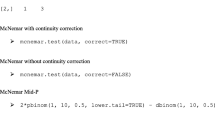Abstract
This research investigated emergent stimulus relations produced by match-to-sample tasks with compound samples and unitary comparisons. The study was a modified replication of the Markham and Dougher study (1993) and consisted of two experiments. Four adults participated in Experiment 1, and 12 6- to 11-year-old children in Experiment 2. Both experiments involved the same training and testing sequence: Training of four AB-C relations (A1B1-C1, A2B2-C1, A1B2-C2, A2B1-C2), followed by C-AB tests (symmetry) and BC-A or AC-B tests, C-D training (C1-D1, C2-D2), D-C tests, D-AB tests (equivalence), and AD-B or BD-A tests. All 16 subjects demonstrated class-consistent C-AB and class-like AC-B or BC-A relations. Of these subjects, 15 also demonstrated class-consistent D-AB and class-like BD-A or AD-B relations.
Similar content being viewed by others
References
ADAMS, B. J., FIELDS, L., & VERHAVE, T. (1993). Effects of test order on the intersubject variability during equivalence class formation. The Psychological Record, 43, 133–152.
BARNES, D. (1994). Stimulus equivalence and relational frame theory. The Psychological Record, 44, 91–124.
BERRYMAN, R., CUMMING, W. W., COHEN, L. R., & JOHNSON, D. E (1965). Acquisition and transfer of stimulus oddity. Psychological Reports, 17, 767–775.
BUSH, K. M., SIDMAN, M., & DEROSE, T. (1989). Contextual control of emergent equivalence relations. Journal of the Experimental Analysis of Behavior, 51, 29–45.
CARTER, D. E., & WERNER, T. J. (1978). Complex learning and information processing in pigeons: A critical analysis. Journal of the Experimental Analysis of Behavior, 29, 565–601.
CULLINAN, V. A., BARNES, D., & SMEETS, P. M. (1998). A precursor to the relational evaluation procedure: Analyzing stimulus equivalence. The Psychological Record, 48, 121–145.
CUMMING, W. W., & BERRYMAN, R. (1965). The complex discriminated operant: Studies of matching-to-sample and related problems. In D. I. Mostofski (Ed.), Stimulus generalization (pp. 284–330). Stanford, CA: Stanford University Press.
DOUGHER, M. J., & MARKHAM, M. R. (1994). Stimulus equivalence, functional equivalence, and the transfer of function. In S. T. Hayes, L. J. Hayes, & K. Ono (Eds.), Behavior analysis of language and cognition (pp. 71–90). Reno, NV: Context Press
FIELDS, L., ADAMS, B. J., NEWMAN, S., & VERHAVE, T. (1992). Interactions among emergent relations during equivalence class formation. The Quarterly Journal of Experimental Psychology, 45B, 125–138.
GATCH, M. B., & OSBORNE, J. G. (1989). Transfer of contextual stimulus function via equivalence class development. Journal of the Experimental Analysis of Behavior, 51, 369–378.
KENNEDY, C. H., & LAITINEN, R. (1988). Second-order conditional control of symmetric and transitive stimulus relations: The influence of order effects. The Psychological Record, 38, 437–446.
LYNCH, D. C., & GREEN, G. (1991). Development and cross modal transfer of contextual control of emergent stimulus relations. Journal of the Experimental Analysis of Behavior, 56, 139–154.
MAGUIRE, R. W., STROMER, R., MACKAY, H. A., & DEMIS, C. A. (1994). Matching to complex samples and stimulus class formation in adults with autism and young children. Journal of Autism and Developmental Disorders, 24, 753–772.
MARKHAM, M. R., & DOUGHER, M. J. (1993). Compound stimuli in emergent stimulus relations: Expending the scope of stimulus equivalence. Journal of the Experimental Analysis of Behavior, 60, 529–542.
PÉREZ-GONZÁLEZ, L. A. (1994). Transfer of relational stimulus control in conditional discriminations. Journal of the Experimental Analysis of Behavior, 61, 487–503.
SAUNDERS, R. R., SAUNDERS, K. J., KIRBY, K. C., & SPRADLIN, J. E. (1988). The merger and development of equivalence classes by unreinforced conditional selection of comparison stimuli. Journal of the Experimental Analysis of Behavior, 50, 145–162.
SCHENK, J. J. (1993). Emergent conditional discriminations in children: Matching to compound stimuli. The Quarterly Journal of Experimental Psychology, 46B, 345–365.
SERNA, R. W. (1991). Interchangeability of stimulus terms in five-term contingencies. Experimental Analysis of Human Behavior Bulletin, 9, 2–3.
SIDMAN, M. (1986). Functional analysis of emergent verbal classes. In T. Thompson & M. Zeiler (Eds.), Analysis and integration of behavioral units (pp. 213–245). Hillsdale, NJ: Erlbaum.
SIDMAN, M., & TAILBY, W. (1982). Conditional discrimination vs matching to sample: An expansion of the testing paradigm. Journal of the Experimental Analysis of Behavior, 37, 5–22.
SMEETS, P. M., BARNES-HOLMES, D., & CULLINAN, V. (2000). Establishing equivalence classes with match-to-sample format and simultaneous- discrimination format conditional discrimination tasks. The Psychological Record, 50, 721–744.
SMEETS, P. M., SCHENK, J. J., & BARNES, D. (1995). Establishing arbitrary stimulus classes via identity-matching training and non-reinforced matching with complex stimuli. The Quarterly Journal of Experimental Psychology, 48B, 311–328.
SMEETS, R M., & STRIEFEL, S. (1994). A revised blocked-trial procedure for establishing arbitrary matching in children. The Quarterly Journal of Experimental Psychology, 47B, 241–261.
STROMER, R., MCILVANE, W. J., & SERNA, R. W. (1993). Complex stimulus control and equivalence. The Psychological Record, 43, 585–598.
STROMER, R., & STROMER, J. B. (1990). The formation of arbitrary stimulus classes in matching to complex samples. The Psychological Record, 40, 51–66.
WILSON, K. G., & HAYES, S. C. (1996). Resurgence of derived stimulus relations. Journal of the Experimental Analysis of Behavior, 66, 267–281.
Author information
Authors and Affiliations
Corresponding author
Rights and permissions
About this article
Cite this article
Carpentier, F., Smeets, P.M. & Barnes-Holmes, D. Matching Compound Samples With Unitary Comparisons: Derived Stimulus Relations in Adults and Children. Psychol Rec 50, 671–685 (2000). https://doi.org/10.1007/BF03395377
Published:
Issue Date:
DOI: https://doi.org/10.1007/BF03395377




